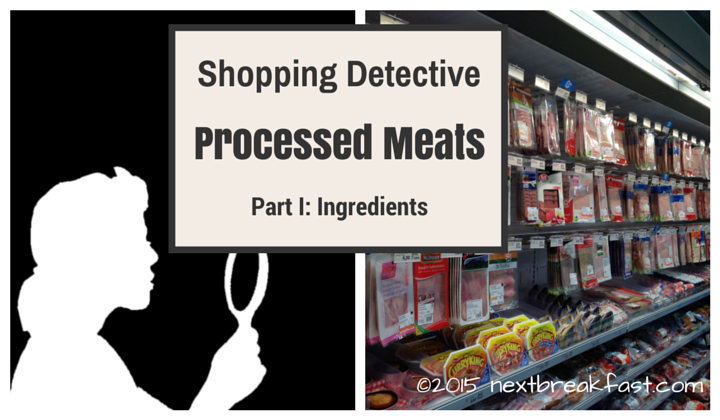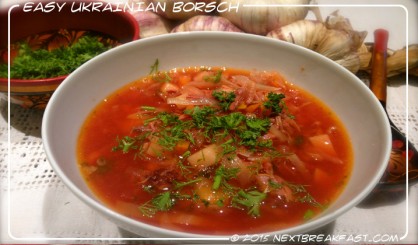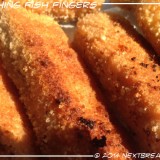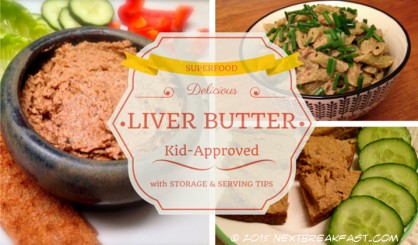Shopping Detective: Processed Meats Part I: Ingredients
BBQ and picnic season is almost here! But shopping for sausages, ham and bacon can be so frustrating – unless you make your own you have to accept a cocktail of sugars and additives OR you Sherlock your labels until you don’t want to eat sausages any more – which is the natural outcome of Sherlock-ing most modern “food” labels…
The simplest solution is to get an organic pork chop on the bone, thats one ingredient, add some salt and pepper, or go crazy and sprinkle with smoked paprika and spear with garlic slivers (+ 4 natural ingredients), bbq it, serve next to a sausage – and let your family and guests decide which one is better.
I actually did this with my then 4 year old, she wanted sausages and she got sausages and I asked her to try an organic pork chop on the bone at the same time – she said “Actually this is much yummier”. So I don’t bother with sausages anymore – I much prefer to get a pork chop or to concoct a spicy or plain beef burger, a minced meat kebab, a chopped leg of lamb on a skewer with loads of onions in between – possibilities are endless!
Ham story is bit less grim – there are properly cured hams with just two ingredients, pork and sea salt, available in supermarkets, but many have a plethora of additives. Again the best and most budget friendly solution is to have some cooked meat (pork, beef or chicken) in the fridge or freezer and use slices for sandwiches and snacks. I often freeze cooked sliced meat in small bags to use as required. The other day I used slices of organic turkey from Christmas in a mild Thai noodle dish. These were thin slices of white breast meat that would also easily go into wraps and salads in place of ham.
When I shop for bacon I also choose the one with minimum number of ingredients, organic or at least free range pork. I slice it before freezing to make it easier to use – in Switzerland bacon is often sold in lumps, so pre-slicing is required.
There are basically four main types of additives you need to know about:
1. Nitrite
2. Sugars
3. Monosodium Glutamate (MSG)
4. Acidity regulators
1. Nitrite – listed as nitrite curing salt or preservative E250 or Nitritpökelsaltz(German)
Here is the definition of what it is:
“Sodium nitrite is the inorganic compound with the chemical formula NaNO2. …it is probably best known as a food additive to prevent botulism.” Wiki
There is a really good easy-to-read post on nitrites and cured meats from Chris Kresser that I encourage you to read. Besides humorously presented facts like:
“It may shock you to learn that one serving of arugula, two servings of butter lettuce, and four servings of celery or beets all have more nitrite than 467 hot dogs. And your own saliva has more nitrites than all of them! So before you eliminate cured meats from your diet, you might want to address your celery intake. And try not to swallow so frequently.”
it provides many scientific reasons with references not to fear nitrites and nitrates:
- neither nitrate nor nitrite accumulate in your body
- major source of nitrite are vegetables
- newer studies find no link between nitrite in the diet and stomach cancer
The problem with processed meats may be all the other additives and not nitrites, which are “metabolized to nitric oxide, a chemical which promotes cardiovascular health and has many other therapeutic effects.”
2.Sugars
Sugars are used as preservatives and flavour enhancers in processed meat. Unfortuately they are ubiquitous even in organic and “friendly” looking products. I REALLY don’t like this sneaky sugar in meats and sausages! Give me please a piece of meat and let ME decide if I want to drench it in sugar or salt or chocolate or whatever – GIVE ME FREEDOM! and we do get our freedom when we buy ingredients in their most unprocessed state (and we own a sausage making machine – I want one!)
But let’s get back to reality. The sugars you are likely to see on sausages, ham and bacon labels are:
Dextrose = D-Glucose
“Not all sugars and sweeteners are derived from the same sources. While table sugar is made from sugar cane, dextrose may be processed from various types of starchy plants” Read more in this live strong post
Glucose = “Traubenzucker” and the difference to dextrose is molecular arrangement, but its generally the same dextrose is D-glucose
Lactose – is a sugar found in milk – this is can be problematic ingredient for those with lactose intolerance.
Sugar – self-explanatory
Glucose syrup – “is a food syrup, made from the hydrolysis of starch. Maize (corn) is commonly used as the source of the starch in the US, in which case the syrup is called “corn syrup”, but glucose syrup is also made from other starch crops, including potatoes, wheat, barley, rice and cassava” Wiki
Maltodextrin – “Maltodextrin is a polysaccharide that is used as a food additive. It is produced from starch by partial hydrolysis…Maltodextrin is used as an inexpensive additive to thicken food products. It is also used as a filler in sugar substitutes and other products.” Wiki
Glycemic index of Maltodextrin can be as high as 135 (glucose, sugar and dextrose have 100 GI). Glycemic Index is an indication of how quickly a specified amount of food will cause a rise in blood sugar level. Blood sugar rise increases insulin production, which is also know as a fat storage hormone, it stimulates lipogenesis (storing of fat). So as I understand it we don’t really want to consume high GI sugars when we are sitting on our bums stuffing our faces with sausages. When you are recovering from a marathon however you might benefit from Maltodextrin as it “will quickly get energy and protein (if accompanied) to your muscles”
As most of the above sugars are derived from various starches, you may be wondering if people with gluten or corn allergies should avoid them. It seems that due to them being highly processed they are safe: Safe Ingredients for Celiac, however there are cases of allergic reactions to corn derived dextrose.
3. Monosodium Glutamate (MSG) listed as MSG, flavour enhancer (Geschmackverstärker), E621, yeast extract (Hefeextrakt)
Monosodium glutamate is the sodium salt of glutamic acid, a naturally-occurring non-essential amino acid (nonessential meaning our bodies can generate it). It is used as a flavour enhancer in processed food.
Glutamate is needed by our bodies and our brains. But MSG that you see added to processed foods is a synthetic chemical and “due to the manufacturing process it is also almost always accompanied by unwanted by-products or contaminants.” (Source:Beyond MSG: Could Hidden Sources of Glutamate Be Harming Your Health?)
Although we love foods with natural glutamic acid – parmesan, sauerkraut and other fermented food, I steer clear of MSG as an additive. The above mentioned article gives thorough explanation of differences between free, bound and synthetic glutamate, clarifies why some people may be sensitive to natural occurring glutamate and concludes that “Even those of us without an identifiable reaction to MSG should aim to avoid this additive due to the lack of reliable safety data.”
This post comes to the same conclusion based on the latest research:
“Despite the lack of evidence to indicate MSG causes adverse symptoms, it’s shaky relationship in causing obesity in humans and the routine of using it to fatten rats and mice leads me to believe that MSG is just not worth the risk to put in your body.”
4. Acidity regulators /anti-oxidants:
These additives seem to be safe but again, due to being highly processed, potentially contaminated – we may want to avoid these too.
acidity regulator ( E262 ) = sodium acetate – seems to be safe
acidity regulator ( E331 ) = sodium citrate – seems to be also safe
ascorbic acid (E300) – synthetic vitamin C, it may be derived from GMO corn (but hopefully not in Switzerland…) – It is considered safe as an additive but read this post to learn more about why high doses may be problematic
stabilizer ( E325 ) – sodium lactate – avoid for children with lactose intolerance.
antioxidant: E301 – sodium ascorbate – may cause allergic reaction in high doses, seems to be safe as an additive.
Of course there are hundreds of additives and I can’t list them all, so here are some good places I found to look up E-numbers:
























Fantastic, thanks for summarizing it so beautifully, printed out, have it in my bag for the next shopping :))
Hope it helps!